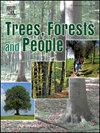Bridging wine and forestry sectors to reduce wildfires: Wine actors’ perceptions, their role in risk reduction and externality labelling
IF 2.7
Q1 FORESTRY
引用次数: 0
Abstract
To mitigate wildfire risk, fire-smart landscapes present a promising strategy, integrating fuel discontinuities through a mosaic of agricultural and forested areas. However, the role of farmers in enhancing wildfire resilience within this mosaic remains underexplored. This exploratory study in four European Mediterranean countries aims at unveiling the factors modulating wine growers’ wildfire risk perception, their related agency and demand for recognition.
Our survey sample consisted of mainly rustic land managers (78 %), which often had also roles of wine producers (48 %), PDO (7.5 %) or winery (18 %) representatives, or wine experts (23 %). Portuguese respondents lead in ownership rates, with Spanish ones exhibiting larger average holdings. Our findings show the interlinkage between wine sector and wildfire risk management: wine growers influence the interface between woodlands and farmlands. Sixty-five percent of land managers were also forest owners, but only 25 % had a forest management plan. Catalan respondents rank higher in association membership, Spanish and Italian respondents tend to have more plans, and Italians are more likely to have sold wood. Approximately 24 % of respondents reported past wildfires within their property, and 32 % in their vicinity. Land managers reported a high wildfire concern (7.5/10), with Spanish respondents scoring higher (8.4) than Portuguese (6.5), French (6.1) and Italians (5.1). The closer experience of wildfires and owning also forests correlated with higher concern levels. Only one-quarter of land managers are aware of a fire prevention plan for their property, and among those pre-suppression measures dominate.
Forty-five percent of respondents declared interest in financial support for implementing wildfire risk reduction measures, followed by technical support (39 %). French respondents were less keen to support. Over one-third-of the sample indicated interest in a fire-smart label in the marketable products to recognise the externality effect of fire risk reduction. Most respondents did not believe that would improve their sales, and 23 % reported excess of brands. These results call for: i) targeted information and financial mechanisms to vineyard managers to align with fire risk reduction measures and engage in forest management, and ii) co-design of any fire-smart produce label to ensure effectiveness and acceptance.
连接葡萄酒和林业部门以减少野火:葡萄酒参与者的看法,他们在降低风险和外部性标签中的作用
为了降低野火风险,火灾智能景观提出了一种很有前途的策略,通过农业和森林地区的马赛克整合燃料不连续性。然而,农民在增强这一“马赛克”中的野火抵御能力方面的作用仍未得到充分探索。本探索性研究在四个欧洲地中海国家的目的是揭示因素调节葡萄酒种植者野火风险感知,他们的相关机构和需求的认可。我们的调查样本主要由乡村土地管理者(78%)组成,他们通常也扮演葡萄酒生产商(48%)、PDO(7.5%)或酿酒厂(18%)代表或葡萄酒专家(23%)的角色。葡萄牙受访者的持股率领先,西班牙受访者的平均持股率更高。我们的研究结果显示了葡萄酒行业与野火风险管理之间的相互联系:葡萄酒种植者影响林地和农田之间的界面。65%的土地管理者同时也是森林所有者,但只有25%的人有森林管理计划。加泰罗尼亚的受访者在协会成员中排名较高,西班牙和意大利的受访者往往有更多的计划,意大利人更有可能出售木材。大约24%的受访者报告说他们的财产内发生过野火,32%的人在他们附近发生过野火。土地管理者报告了对野火的高度关注(7.5/10),西班牙受访者的得分(8.4)高于葡萄牙(6.5)、法国(6.1)和意大利(5.1)。更接近野火和拥有森林的经历与更高的关注水平相关。只有四分之一的土地管理者知道他们的财产有防火计划,在这些预灭火措施中占主导地位。45%的受访者表示有兴趣为实施减少野火风险措施提供财政支持,其次是技术支持(39%)。法国受访者则不太支持。超过三分之一的样本表示有兴趣在可销售的产品中使用防火智能标签,以识别降低火灾风险的外部性效应。大多数受访者不相信这会提高他们的销售额,23%的受访者表示品牌过多。这些结果要求:i)向葡萄园管理者提供有针对性的信息和金融机制,以配合减少火灾风险的措施并参与森林管理;ii)共同设计任何防火智能产品标签,以确保有效性和可接受性。
本文章由计算机程序翻译,如有差异,请以英文原文为准。
求助全文
约1分钟内获得全文
求助全文
来源期刊

Trees, Forests and People
Economics, Econometrics and Finance-Economics, Econometrics and Finance (miscellaneous)
CiteScore
4.30
自引率
7.40%
发文量
172
审稿时长
56 days
 求助内容:
求助内容: 应助结果提醒方式:
应助结果提醒方式:


